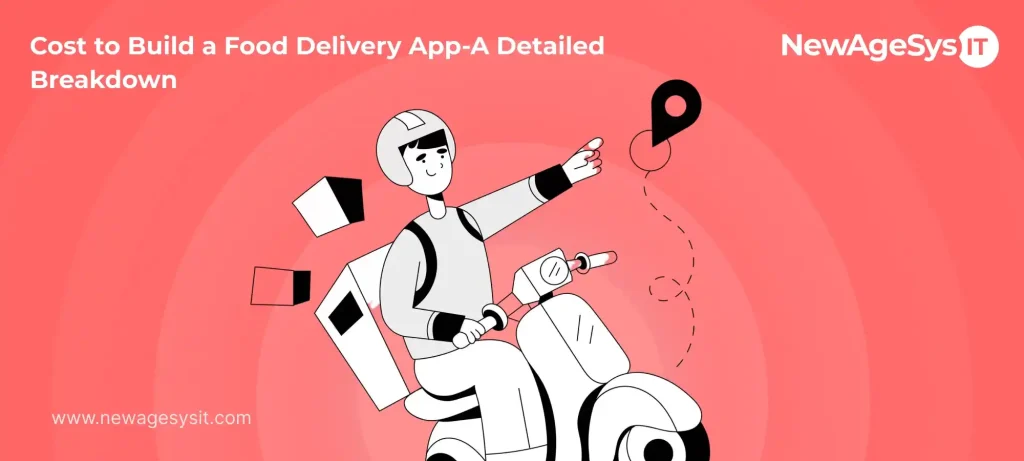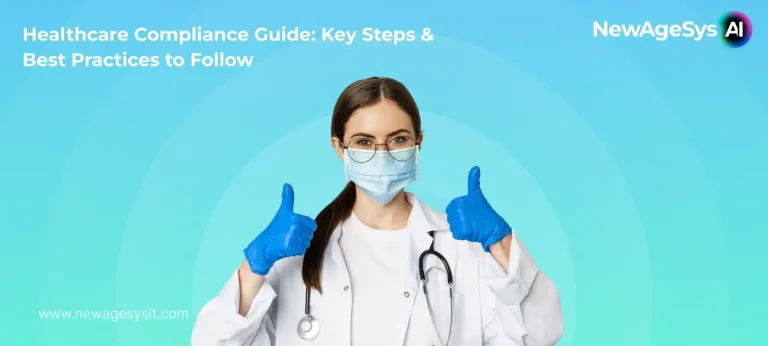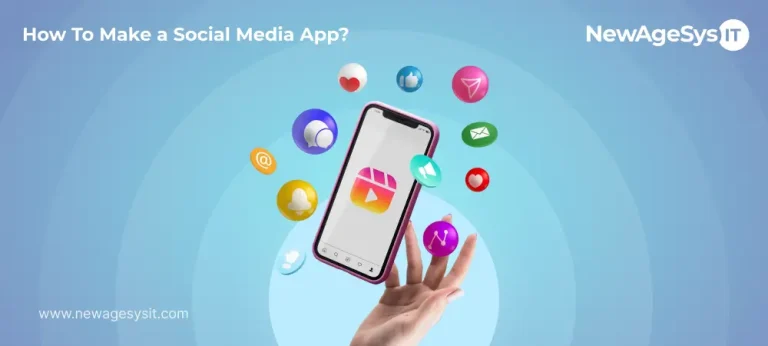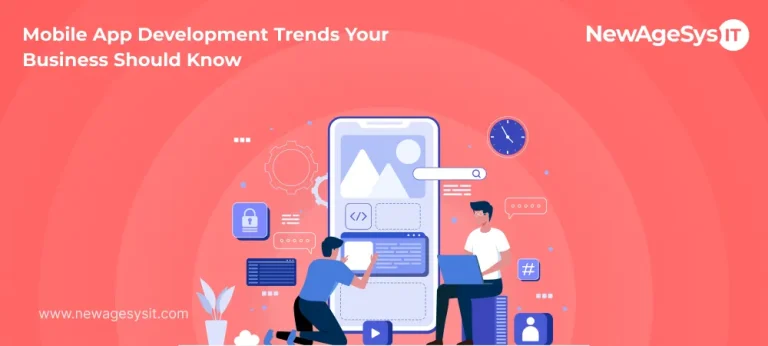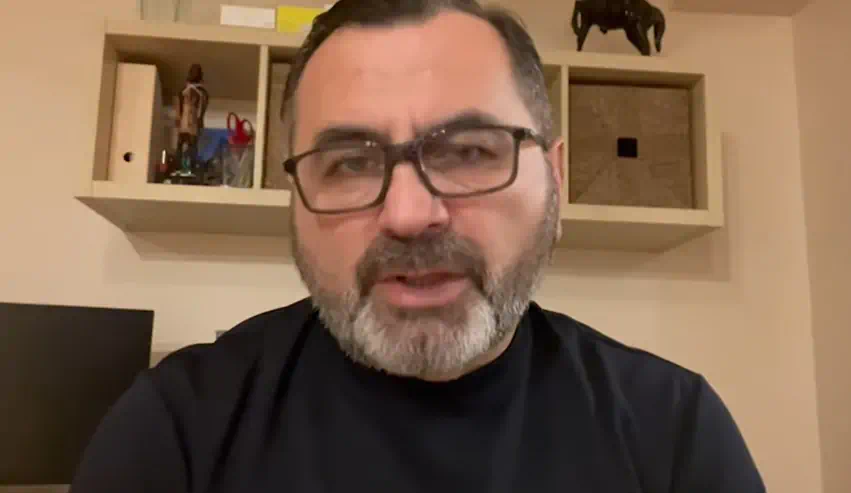| Key takeaways: Stats reveal that the online food delivery market is expected to increase from $1.39 trillion in 2025 to $2.02 trillion by 2030 globally, with a CAGR of 7.64%, indicating a strong opportunity for businesses entering this space. Developing a food delivery app involves various cost-driving factors, including app complexity, chosen features, tech stack, design, development team location, and maintenance requirements. A basic food delivery app with essential features can start at $5,000 to $20,000, whereas a full-featured, scalable app like DoorDash or Uber Eats can cost $50,000 to $300,000+, depending on its functionality and technical integrations. Advanced features, such as real-time tracking, AI-based suggestions, loyalty programs, and third-party integrations, have a significant impact on both development costs and user engagement. Utilizing cost-saving techniques, like MVP development, cross-platform frameworks, outsourcing to cost-effective regions, and leveraging cloud services, can reduce overall development costs by up to 25% or more. |
The food delivery app segment is undergoing a phenomenal digital transformation—the rise of popular food delivery apps like DoorDash and Uber Eats has been extensive, making it easier for customers to get their favorite food delivered to their doorsteps. Want to develop a food delivery app? Does the food delivery app development cost hold you back? Are you aware of the revenue you can generate with these apps?
Food delivery apps generate revenue through various streams, including commissions from restaurants and fees charged to customers for the delivery service. The revenue also includes premium subscription services, partnerships with restaurants, and advertisements to make extra earnings. The profitability of an application is based on the following: competition, user engagement, operational costs, etc. A food delivery app also creates numerous job opportunities in the market, which is another significant advantage. According to the recent Statista report, the global online food delivery app development market is expected to hit US$2.02 trillion by 2029, with a 7.64% CAGR, over the period 2025-2030.
As demand grows, businesses become keen to explore the market and start considering the development of their app. However, here you need to consider many aspects—the cost of food delivery app can vary based on platform complexity, features, team location, and various other factors. It is crucial to compare the cost factors while launching your food delivery app. In this blog, let’s learn the key facets that influence the overall cost of developing food delivery app, and many other points you need to consider while launching the app to the market.
Why Invest in Food Delivery App Development: Market Overview
Food delivery apps have experienced an increased usage as they provide excellent solutions for businesses, restaurants, and customers. According to Statista, DoorDash, a well-known food delivery provider based in the U.S., holds a market share of approximately 67%. Meanwhile, Uber Eats takes the second-highest position with a 23% share.
The graph below shows the worldwide revenue projection for the online food ordering app development market over the period 2025-2030. Also, the food delivery market revenue is expected to surge from $1.39 trillion in 2025 to approximately $2.02 trillion in 2030, representing a compound annual growth rate (CAGR) of 7.64%, according to a recent report.
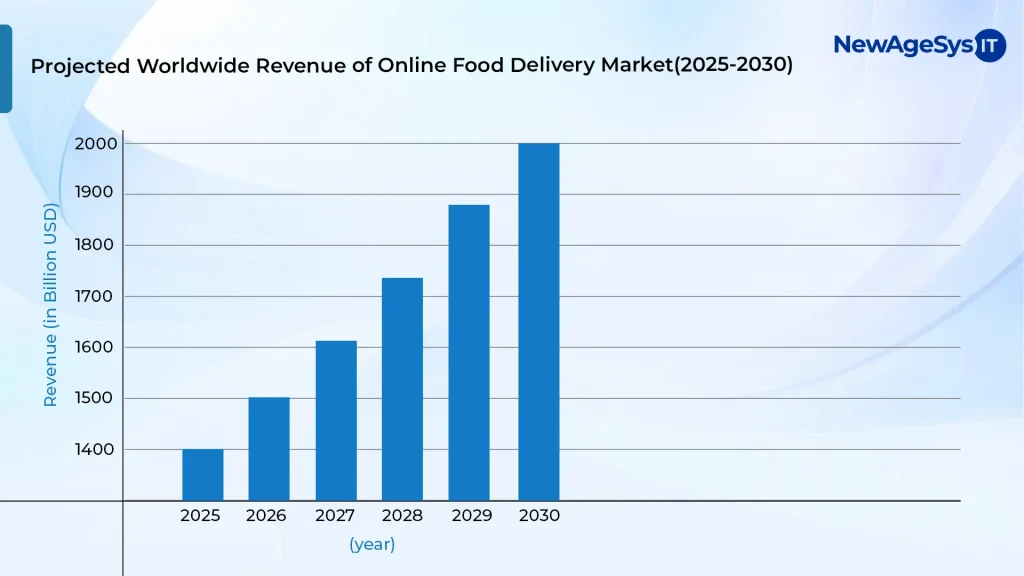
If you wish to enter this rapidly evolving segment, launching your food delivery app would be an ideal choice. However, app development costs could pose challenges, particularly for startups with low budgets. We recommend partnering with a reputable food delivery app development company to access cost-effective services and build the app your business desires.
Cost to Develop a Food Delivery App (Based on Popular Apps)
Suppose you look at the popular apps like Uber Eats, DoorDash, or Postmates. In this case, the overall cost to develop a food delivery app might vary based on the aspects or factors incorporated, the app’s complexity, platform, the development team’s location, and many other factors. However, here is a walkthrough of the estimated costs of these apps.
Cost of developing food delivery app like DoorDash
Building an app like DoorDash can cost somewhere between $70,000 and $3,00,000+ based on its complexity. The costs also depend on the features of the food delivery app you wish to add and the scope of the app project.
Key Features:
- Seamless onboarding for restaurants, users, and delivery personnel
- Smart delivery tracking and order assignment
- Real-time GPS and driver route optimization
- In-app wallet and secure payments
- Promotional codes and referrals
- Admin dashboard with user management and advanced analytics
Cost of developing food delivery app like Uber Eats
Building an app like Uber Eats can cost somewhere between $70,000 and $3,00,000+ based on the app complexity. The cost also depends on the features you need to incorporate and the scope of the app project.
Key Features:
- User-friendly interface to enable food discovery
- High-end search and filters
- In-app chat feature for customer support
- Scheduled delivery
- Comprehensive analytics for restaurant partners
- Loyalty programs and discounts
Cost of developing food delivery app like Postmates
Building an app like Postmates can cost somewhere between $50,000 and $2,50,000+ based on the app complexity. The app development cost can also vary with the features and scope of the project.
Key Features:
- User registration and profiles
- Restaurant menu and listings
- Real-time order monitoring
- Payment gateway integration
- Reviews and ratings
- Admin panel to manage orders
Cost of developing food delivery app like Grubhub
Building an app like Grubhub can cost anywhere between $60,000 and $250,000. Calculating the overall cost to create a food delivery app also considers the complexity, features, and the scope of the project.
Key Features:
- User and restaurant registration
- Order management system
- Multiple payment features
- Push notifications to enable order updates
- User reviews and feedback
- Third-party integrations
Factors Affecting the Food Delivery App Development Costs
A food delivery app development project involves many factors that can influence the overall app development costs. Since every app is different, the cost of developing them differs. It highly relies on the features you wish to choose, the tech stack you go for, and where the development team is sourced.
Regardless of a simple restaurant app development or creating a feature-specific and complex application like DoorDash or Uber Eats, it’s essential to be mindful of these aspects. In this section, let’s break down the vital factors that impact the costs of developing a food delivery app.
1. App Complexity
When estimating the costs of food delivery apps, the complexity of the app plays a critical role. The higher the app complexity, the higher the cost of app development. While simple apps with essential features typically cost $5,000-$20,000 and require less time to develop, complex apps can cost $30,000+ and offer superior functionalities, such as high-end UI/UX design, third-party integrations, and custom features.
Let’s have a look at the food delivery application pricing as per the app size:
| App Complexity | Hourly Rate | Estimated Cost to Build the App |
|---|---|---|
| Basic | $20 | $5,000 – $20,000 |
| Intermediate | $40 | $25,000 – $40,000 |
| Complex | $100 | $45,000 – $60,000 |
2. App Features
Another factor that contributes to the food delivery app development cost is the features you wish to include in the app. Simple apps that incorporate basic features, such as placing an order, registration, or payment integration, cost approximately $5,000 or more. Whereas, when you wish to integrate top-notch features or functions into your app, it would take roughly $20,000 to $50,000 or more, depending on the time and effort required by the app. Here’s a table that shows a rough estimate for the app development costs based on features:
| App Features | Estimated Cost |
|---|---|
| Basic ordering and payment integration | $4,000 – $6,000 |
| User registration and profile management | $2,500 – $4,500 |
| Real-time order monitoring | $6,000 – $10,000 |
| Push notifications | $1,500 – $3,000 |
| Multi-payment gateways | $3,500 – $7,000 |
| Loyalty programs | $4,000 – $8,000 |
| AI-based suggestions | $12,000- $20,000 |
| Custom recommendations | $15,000- $25,000 |
| Restaurant dashboard | $7,000- $13,000 |
| Advanced reporting and analytics | $8,000- $15,000 |
3. Development Team’s Location
Another factor affecting the cost of building a food delivery app is the development team’s location. If you are outside the United States, such as in Europe or North America, the price is between $100 and $200 per hour. On the contrary, if you choose an app development company based on your region, you can get cost-effective food delivery app development services. Go for the option that goes hand-in-hand with your budget.
| Region | Estimated Hourly Cost |
|---|---|
| North America (USA, Canada) | $100-$200 |
| Western Europe (UK, Germany, France) | $80-$150 |
| Eastern Europe (Ukraine, Poland, Romania) | $30-$70 |
| Pakistan/India | $20-$50 |
| South-East Asia (Philippines, Vietnam, Indonesia) | $20-$40 |
| Local Developers in the USA/Local Cities | $50-$80 |
4. Technology Stack
The technology stack used in food delivery app development typically includes both front-end (what users interact with) and back-end components (databases, servers). Check if they integrate advanced technologies or custom features, such as real-time data sync, AI-driven features, and security functions. The tech stack used in your app affects the total cost of food delivery app development.
| Tech Stack | Expected Cost |
|---|---|
| Simple | $5000 to $10000+ |
| Medium | $15000 to $25000+ |
| Advanced | $35000 to $50000+ |
5. App Maintenance
Building a food delivery app involves costs that extend beyond one-time expenses. Once the app gets launched, the maintenance is an ongoing process. It includes fixing bugs, implementing performance updates, updating the app to meet the latest OS standards, and introducing new features over time. It is advisable to hire a reliable app development company to determine the ideal maintenance costs associated with developing a food delivery app. It should consider the long-term success of your food delivery app.
| Maintenance Type | Description | Estimated Monthly Cost |
|---|---|---|
| Regular bug fixes and updates | Bug fixing and performance enhancements | $1,000-$5,000 |
| Core feature updates | New app upgrades, additional features, or system improvements | $10,000+ for each update |
| System compatibility issues | To meet the latest OS fixes | $2,000-$4,000 |
6. App Design (UI/UX)
App design can influence the total cost of developing a food delivery app. A well-designed and user-friendly (UI) interface, along with a high-end user experience (UX), is essential for success. In case you need custom animations, designs, or unique themes, it can increase the total costs. A high-quality design lays the cornerstone for visually stunning and easy-to-navigate application features.
| UI/UX Design | Features | Expected Cost |
|---|---|---|
| Simple | Basic design | $3,000- $5,000 |
| Advanced | Custom design | $10,000-$20,000 |
| Premium | Highly creative design | $20,000-$30,000 |
Why Is It Important to Have a Food Delivery App?
Creating a food delivery app is a one-stop solution that lets you scale your business and helps you rise above the competition. With an on-demand food delivery app development system, you can make it cost-effective and advantageous in the long run. Here are the benefits of food delivery apps:
Enhance Visibility
People are increasingly interested in ordering food online through food applications. An online app lets you gain more opportunities to improve your visibility. An online presence for your restaurant can help you rank higher and reach more customers. Using a dedicated food ordering and delivery application, you can let your restaurant reach the target market and win customers’ trust.
Streamline Online Ordering
A food delivery management app helps restaurants thrive in the competitive niche. It allows restaurants to replace manual orders and streamline order management. Customers can also monitor their order deliveries with the app for a great experience. This helps boost customer satisfaction by keeping customers aware of their orders.
Improve Revenue
Food business owners can leverage technology to transform their restaurants into digital platforms, increasing their earnings and success. With a food ordering app, you can attract new customers and improve sales.
Commission Charges
Platform owners can increase revenue by charging restaurants a fee for every order placed through the platform. This is specifically a percentage of the overall order value.
Delivery Charges
In addition to costs such as gas, rider salary, and vehicle maintenance, you can also include an extra service charge in the overall delivery amount. It allows you to cover expenses and generate additional revenue.
Advertising & Promotions
Food delivery app helps in promotions, discounts, and notifies customers about the offers.
Global Search
You can reach customers beyond your local area. The app allows you to explore new markets and serve a broader customer base, which is useful when you need to expand your business’s operations to various countries.
Cost Effectiveness
Building a food delivery app replaces the need to invest in physical storefronts. To get the food delivery service running, you need to level up its resources to improve traffic. With a food delivery platform, you can save costs. You don’t need to share your profits with third-party platforms. With third-party platforms, you would need to pay approximately 30-40% more in additional costs.
What Features Do You Need in Your Food Delivery App?
Features also play a significant role in analyzing the cost. Before building a food delivery app, you should choose the features to be added to the app. Let’s see a list of features to be included in the online ordering application.
Customer App
- User Registration: Users can create an account with name, email address, and phone number.
- Advanced Search Features: Users can browse various restaurants and cuisines based on ratings, price, and other criteria.
- Real-Time Order Monitoring: The User can track orders in real-time and know when they receive them.
- Reviews/Ratings: Users can share their feedback.
- Multiple Payment Options: Helps users improve the chances of driving customers.
- Push notifications: Helps users know about any specific offers, discounts, and the best deals.
- Social Media Integration: Users can link the app to their social network accounts. This helps them share images, videos, and reviews, among their social circles.
- Order Customization: Users can customize the order based on their preferences.
- Order History: This helps users view their previous orders, reorder their favorites, and save time searching for their most frequently ordered items.
- Add Preferred Restaurants: Let users add their favourite food items or restaurants to their favourites to make ordering fast and easy.
Restaurant App
- Order Management that enables restaurants to easily accept or reject orders based on availability.
- Menu Management helps restaurants add, edit, and update menu items, like photos, prices, etc.
- Analytics & Reporting to let restaurants optimize their operations by using analytics to gather information about popular products, users’ interests, and delivery times.
- Promotions & Discounts, where restaurants can reward loyal customers, gain new buyers, and increase sales and revenue.
Rider App
- Account Creation: Riders can easily create, edit, and update their account information.
- Order History: Riders can check the order status (delivered and pending status).
- Accept & Manage Deliveries: Riders can accept and reject deliveries based on their choice and workload.
- Route Optimization: Riders can monitor their delivery time and route using map integration and navigation tools.
- Earning History: Riders can view their earnings and payments. Through this method, riders can track their timely payments and earnings.
- In-App Messaging: Riders can communicate with customers and update them on orders, eliminating miscommunication between the two parties.
Admin Dashboard Feature
- Restaurant Management: Ideal for restaurants to manage the orders, and food delivery.
- Rider Management: Great to manage rides and monitor deliveries.
- Customer Management: Admins can view and manage customer details, including order history, contact, and users’ demands. This information is helpful in providing personalized services, managing customer queries, and retaining customers.
- Payment Management: Helps admins to view and manage transaction details, refunds, and pending payments.
- Discounts, Offers, & Coupons: Enables admins to create and manage promotions. Admins can set up discounts on specific items or order totals to develop promotional offers for particular occasions and generate coupon codes.

Compliance Costs Breakdown for Food Delivery Apps (USA )
In addition to the generic app development costs, you should also consider the app compliances to build a food delivery app in the USA. Here is a list of compliances you need to follow to ensure adherence to the region’s regulations and standards, and respective costs.
| Compliance Area | Definition | Cost Type | Estimated Cost (USD) |
|---|---|---|---|
| Data Privacy (CCPA, COPPA) | Protect users’ personal data and privacy rights | Legal, tech | $2,000 – $10,000+ |
| Payment Compliance (PCI-DSS) | Security standards to manage and process credit card payments | Tech, 3rd party | Free – $2,000+ |
| Labor Laws (AB5, Contracts) | Focuses on fair treatment and classification of gig workers | Legal, HR | $1,000 – $5,000+ |
| Food Safety & Licensing (Restaurants) | Health code and licensing needs for restaurants that sell food | App side | Generally free |
| T&C’s, Privacy Policy, Disclaimers | Contracts and policies that define user rights and platform responsibilities | Legal | $500 – $2,500+ |
| Business Licenses & Tax Registration | Government-required permits to operate legally and collect taxes | Government Fees | $100 – $1,000 per state/city |
| ADA Compliance (Accessibility) | Rules to make digital services usable for people with disabilities | Developer/UX time | $500 – $5,000+ |
| Dispute Resolution, Refund Policy | Clear policies to handle users’ concerns, cancellations, and refunds | Legal | $500–$2,000+ |
Food Delivery App Development Process
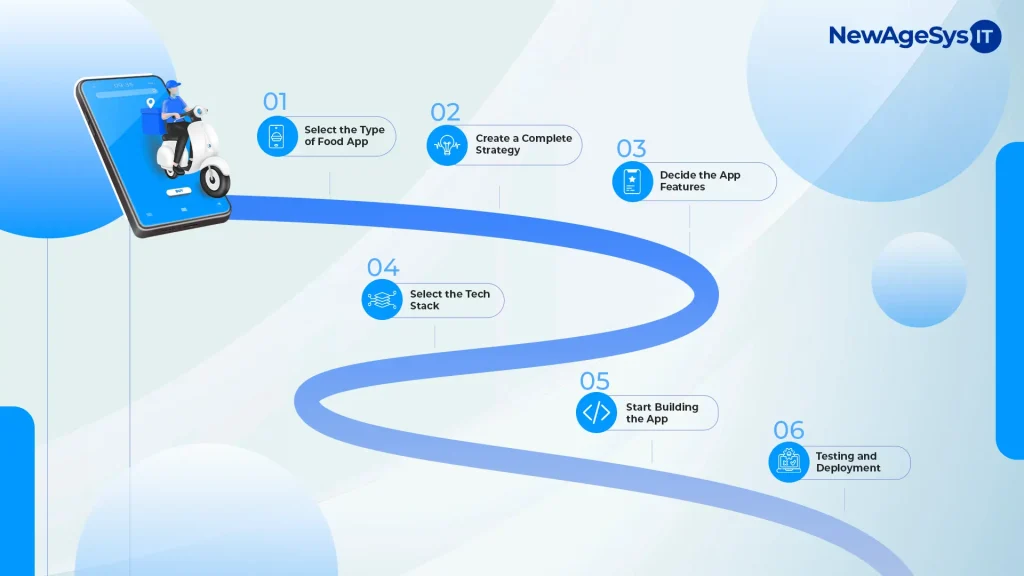
How to build a food delivery app? Here are the steps for food delivery app development that briefly explain the flow:
- Choose the Type of Food App
Understand the type of food delivery service you wish to offer. Know the target audience and their needs. Additionally, research the competition to identify market gaps by examining their offerings. Specify the type of food delivery service you wish to offer. Additionally, know your target audience and what they need. Research the competition and understand their offerings to identify market gaps and opportunities.
- Build a Marketing Strategy
Understand your business model and the revenue model (commission-based or subscription model, etc.). Build a marketing strategy to attract your customers. Also, to determine the app success, pick the Key Performance Indicators, i.e., (KPIs).
- Pick the App Features
Choose the key app features. Ensure you add these features that are relevant to the users. Core features include user registration, payment integration, order placement, browsing, and more. The advanced features include personalization, third-party integrations, push notifications, and more.
- Go for the Tech Stack
Choosing the right tech stack is essential, along with selecting the correct set of programming languages or app frameworks. Select relevant technologies, align your app requirements, and work with an expert development team.
- Build the App
Decide on UI/UX design that best fits what the target audience needs. Build front-end and back-end app components, and execute core and complex features.
- Testing & Deployment
Identify and detect any potential bugs or issues. Do user acceptance testing to make sure the application meets the needs and provides a great experience. Optimize the app for IT security, performance, and high scalability. Deploy the app to the stores and continuously track its performance to make necessary changes based on user feedback.
Tips & Tricks to Reduce the Cost of Food Delivery App Development
Although food delivery or restaurant app development cost can be high, you can maintain quality and reduce expenses with thoughtful planning. Let’s break down the practical ways to minimize the cost of making a food ordering app:
MVP Development
Rather than working on a completely functional software, go for MVP development with basic processes. It reduces app development costs and helps to collect consumers’ ratings/feedback.
Pre-Built Solutions
Utilize third-party APIs to facilitate push notifications, mapping, and payment processing. Testing and optimizing pre-built solutions help to ensure cost efficiency, time savings, and reliability.
Outsource Cost-Effective Regions
You can save costs through outsourcing, i.e., hire dedicated app developers or a reliable app development company. With the help of app developers and their proficiency in mobile app development services, you can benefit from the competitive prices.
Choose the Right Development Platform
The commonly used app development platforms are native app development (iOS, Android) and cross-platform app development (React Native, Flutter), among others. You can go for one of these commonly used development platforms to make it cost-effective and worthwhile.
List Core Features
While complex features like AI-specific suggestions can be added after gathering user feedback or over time, focus on essential functions such as ordering, payment integration, and monitoring. This strategy can let you minimize the cost of developing a food delivery app and optimize the costs.
Cloud-Based Backend
Using cloud services, for example, Azure, AWS services, etc; reduces overall infrastructure costs. Cloud-based backend lets you eliminate the heavy server maintenance for scalability.
Final Thoughts
Your business objectives and budget considerations should be effectively balanced to decide on the cost of building a food delivery app. Investing in advanced features, such as AI/ML capabilities, advanced technologies, and real-time analytics, can give you an edge, but ensure you have planned your budget to avoid unexpected costs. The proper process to follow is to begin with a simple Minimum Viable Product (MVP), incorporating the essential features for a quick start.
Consequently, you can have a premium version that takes user feedback and market changes into consideration. By now, you should have a clear understanding of the development cost of a food delivery app, depending on your project requirements. However, having a phased approach and the assistance of an app development company to guide you effectively in building cost-effective food delivery apps can make your approach smoother and more efficient. To learn more about the app development costs and to get an app development cost estimate for your next project, reach out to us!
FAQ
1. How much does it cost to maintain an app?
App maintenance costs can depend on various factors, including the frequency of app updates, the technology stack, the development team size, and the app’s complexity. As a leading software development company, we offer app maintenance and support services to help you with the process.
2. How much does it cost to build an app like DoorDash?
The cost to build an app like DoorDash can range between $50,000 and $500,000+, and differ depending on the features, complexity, and targeted platforms.
3. What should I do to hire a food delivery app developer in the USA?
To hire a food delivery app developer in the USA,
- List the core features and development budget.
- Select a reputable app development company in the United States.
- Review previous projects and the experience of the team.
- Ensure the development team has the necessary skills.
- Build a clear development roadmap.
4. How much time do you need to build food delivery applications?
Based on the app’s intricacy, developing food delivery apps usually takes weeks to months. A complex app driven by AI and other advanced features can take a significant amount of time, while it can take weeks to months for a basic app.
5. Are there any fees involved in app publishing?
Obviously, Google Play Store would levy a $25 one-time fee for app publishing, while the App Store requires an annual payment of $99. These costs contribute to the overall expense of making the app visible and available to a large audience.
6. How do food delivery apps make money?
Food delivery apps generate money through various revenue streams. It includes commissions from the restaurants and delivery fees levied on customers. It also includes partnerships with restaurants, subscription services, and advertisements to make an extra source of income.

